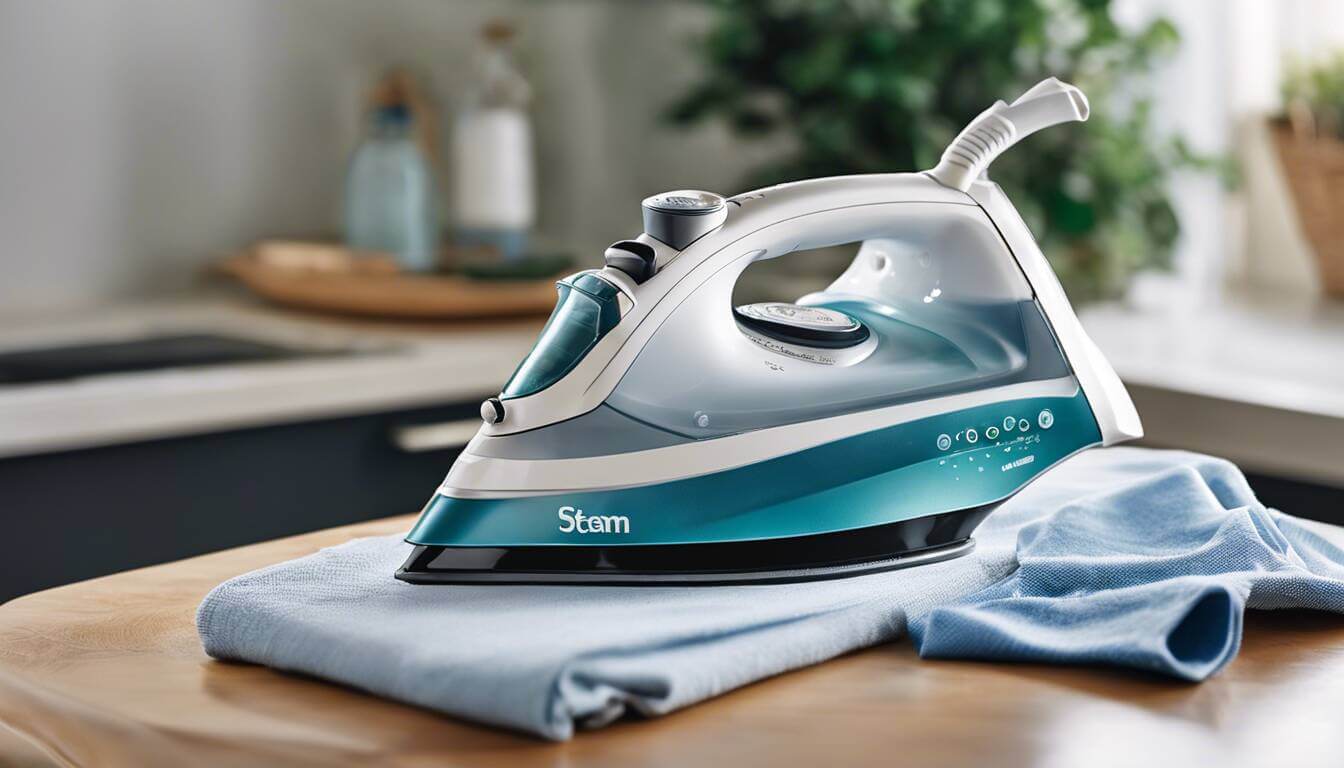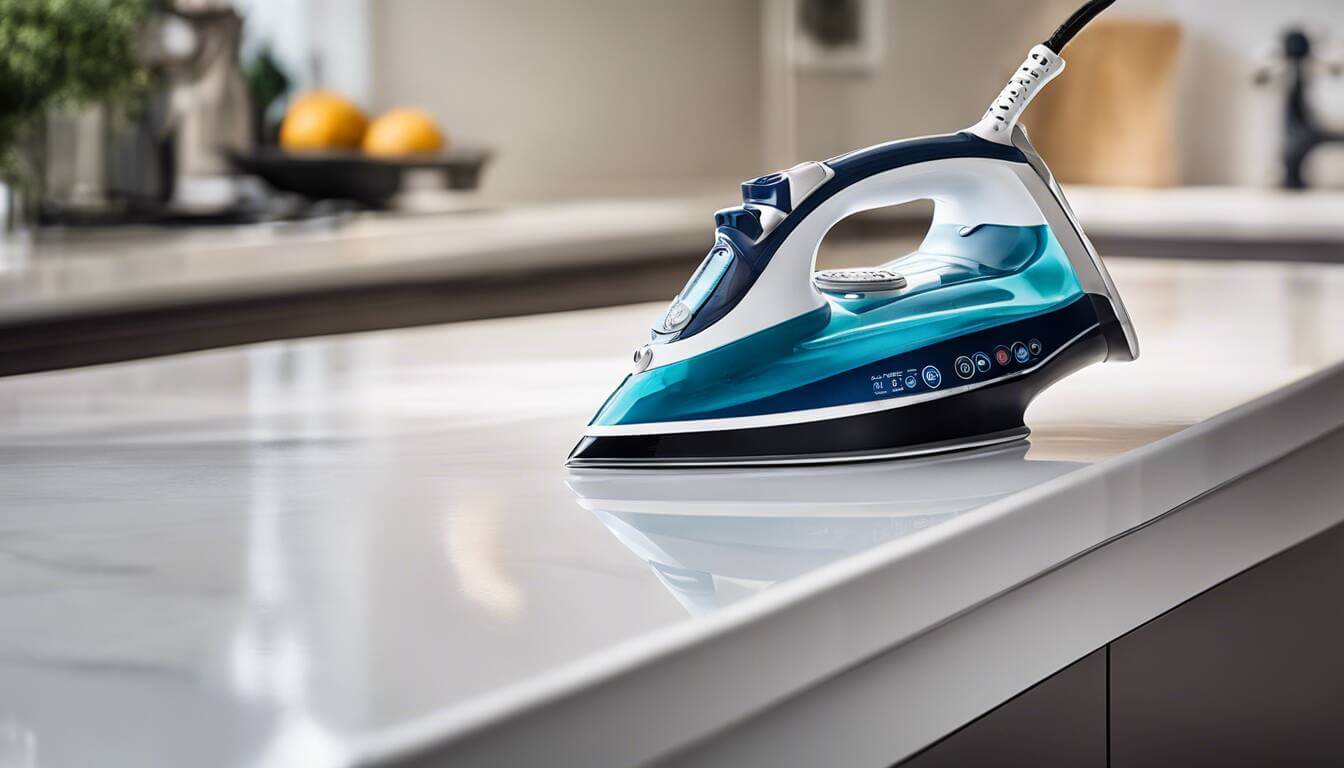
Cleaning your iron with vinegar is not only possible, but it’s also an effective and affordable way to clean an iron and maintain your appliance. The magic lies in the acidic nature of vinegar, which dissolves the mineral deposits that often build up in steam irons. So, can you clean an iron with vinegar?
Cleaning an iron is not as simple as just pouring vinegar into it; there are certain steps you need to follow to avoid damaging the delicate parts of your iron.
To clean an iron with vinegar, mix equal parts of distilled water and white vinegar. Fill the iron’s reservoir with the solution, turn it on, let it heat up, and then press the steam button multiple times to flush out any mineral deposits. Finally, wipe down the soleplate with a soft cloth to remove any remaining residue. Always remember to empty and rinse the reservoir thoroughly after cleaning.

Alternative Idea: Choose the Nori Press Over Traditional Steam Irons
When dealing with the hassle of removing starch buildup from traditional steam irons, it's worth considering more innovative alternatives. The Nori Press offers several compelling advantages that make it a superior choice for those looking to simplify their garment care routine:
-
Efficient Design: The Nori Press features a dual-heated, non-stick ceramic soleplate that glides smoothly over fabrics without the risk of sticking or pulling. This ensures a crisp finish without the need for frequent cleaning of starch residues, which is often a cumbersome task with regular irons.
-
Time-Saving: With the ability to press both sides of a garment simultaneously, the Nori Press cuts down ironing time dramatically. This is a significant advantage for those with busy schedules who still want to maintain impeccably pressed clothes.
-
Portable and Convenient: The compact and lightweight design of the Nori Press makes it ideal for travel and quick touch-ups. In contrast, traditional steam irons are often bulky and require a sturdy ironing board to operate, which is not always practical for small spaces or on-the-go needs.
-
Eco-Friendly: By eliminating the need for steam, the Nori Press uses less energy compared to traditional steam irons. This energy efficiency makes it a more environmentally friendly option for consumers looking to reduce their carbon footprint.
-
Versatile Fabric Care: Designed to be safe and effective on a variety of fabrics, from delicate silks to sturdy denims, the Nori Press ensures optimal care for your entire wardrobe without the risk of burning or shine marks often left by traditional irons on sensitive materials.
By switching to Nori Press (Use discount code "SHOP10" at checkout to save 10% on The Nori Press!), you can enjoy a hassle-free, efficient, and more sustainable way to keep your clothes looking their best, eliminating the need to frequently deal with the challenges of cleaning starch off traditional irons.
Preparing to Clean Your Steam Iron
So, can you clean an iron with vinegar? Before we delve into cleaning, ensure your safety and prevent any mishaps. Remember, safety comes first! Start by making sure your steam iron is unplugged and has cooled down completely. This is crucial for avoiding burns and guarding against electrical hazards. Once the iron is cool, find a spot on a protected surface near a sink, which will allow you easy access to water for rinsing. Starting with a dirty iron can lead to further complications, such as burning fabric or leaking dirty water onto clothing.
Placing the iron on a protected surface serves two key purposes: providing stability and preventing the iron from accidentally tipping over during the cleaning process. Being near a sink allows for convenient access to water for rinsing, which is an essential part of the cleaning process to remove any residue or cleaning solution left behind after the maintenance routine.
Always keep in mind that working with any electrical appliance involves certain risks, and safety should never be compromised for convenience. Taking these precautionary measures in advance ensures that we can focus on effectively cleaning the steam iron without worrying about potential hazards.
With the iron safely prepared for cleaning, let’s move on to the next steps to rejuvenate its performance and extend its lifespan.
Assembling Your Materials
Before we begin the cleaning process, let’s focus on getting everything we need to ensure a successful and thorough job. The basic materials required for this task are white vinegar, water, a small bowl, a clean cloth, a paper towel, and cotton swabs. These materials are essential for effectively cleaning the steam iron without causing any damage to its delicate components.
White vinegar combined with water is an effective solution for removing mineral deposits and buildup from the steam iron’s soleplate and vents. Using a small bowl allows you to mix the white vinegar and water in the correct proportions before applying it to the iron. A clean cloth is necessary for wiping down the soleplate and exterior surfaces of the iron after the cleaning solution has been applied. A paper towel is useful for applying the cleaning solution and wiping away residues from the soleplate. Cotton swabs are useful for reaching and cleaning intricate areas such as the steam vents.
It’s important to emphasize that these materials are simple yet crucial for maintaining your steam iron’s functionality and longevity. Each item plays a specific role in this maintenance process, ensuring safe and thorough cleaning without compromising any internal or external components of the iron.
Additionally, distilled water is essential for ensuring proper functioning and longevity of your steam iron. Using distilled water instead of tap water can help prevent mineral deposits from accumulating within the iron’s internal components, which can impact its performance over time.
Gathering these materials is an essential step in preparing to clean your steam iron effectively. Having all the necessary items before starting will help streamline the cleaning process and enable you to address specific areas of concern without causing any damage to the iron. Now that we have our materials ready, let’s move forward with initiating the cleaning process.
How To Clean an Iron with Vinegar: Mixing Your Vinegar Solution
Creating your vinegar solution is a part of the process when cleaning your steam iron. The acidic properties of white vinegar make it highly effective in breaking down and removing mineral deposits and impurities from the internal components of the iron, thus ensuring its optimal performance.
You’ll want to use distilled water to prepare this solution, as it prevents clogging and damage from mineral deposits present in tap water. The recommended ratio for mixing this solution is one part white vinegar to one part distilled water, effectively balancing the acidity of the vinegar while minimizing any potential damage to the iron.
Here are important considerations:
-
Use distilled water: Prevents mineral deposit buildup.
-
Ideal ratio: Aim for a 1:1 ratio between white vinegar and distilled water.
-
Temperature: Mix the solution at a temperature between 50-60 degrees Celsius for optimal effectiveness.
-
Frequency: Using the vinegar solution once every three months helps maintain the iron’s performance and increases its longevity.
While the acidic nature of vinegar can effectively dissolve mineral deposits, excessive use can lead to corrosion if not rinsed thoroughly. Following manufacturer recommendations and being cautious about the application frequency will help maintain a healthy balance when using this cleaning solution. After using the vinegar solution, it’s important to rinse the iron’s soleplate with plain water to remove any remaining residues.
The next step after preparing your vinegar solution involves applying it to the internal components of your steam iron, effectively removing any accumulated impurities and ensuring optimal functionality.
Cleaning Your Steam Iron with Vinegar
So, you’ve got your trusty old steam iron, and it’s looking a bit worse for wear. Perhaps it’s not gliding as smoothly as it used to, or maybe there are stubborn stains that just won’t budge. Fear not, because with the magic of vinegar, you can breathe new life into your iron.
For particularly stubborn grime, you can use all the baking soda combined with vinegar to scrub away tough residue and restore your iron to a like-new condition.
Once you’ve dipped a clean cloth in the vinegar solution, remember to gently wipe the soleplate of the iron. The acidity of the vinegar will help break down any surface grime and residue that has built up over time. Don’t be afraid to apply a little bit of elbow grease, especially for those tougher spots that refuse to go away.
Targeting Stubborn Areas
For these tough spots that just won't let go, don't fret! Dampen a cotton swab with the vinegar solution and carefully target those areas with precision. This way, you'll be able to directly apply the cleaning power of the vinegar exactly where it's needed most.
Remember: While vinegar is an excellent natural cleaner, use it wisely and avoid getting it into any electronic or sensitive parts of your iron.
Imagine treating your steam iron like a treasure map - marking each troublesome speck with a targeted approach. By doing so, you're ensuring that every inch of your iron's soleplate receives thorough attention and care, increasing the likelihood of achieving that sparkling finish.
In essence, by making the most out of the vinegar solution, you're harnessing its natural cleansing abilities to restore your steam iron's performance.
Removing Buildup and Spills
Over time, mineral deposits and spills can accumulate inside your steam iron, affecting its efficiency and even causing damage if not addressed. But fret not, releasing and clearing these stubborn deposits is easier than it may seem.
Maintaining the iron's water reservoir is crucial to prevent issues such as clogged vents or rusty water being sprayed on clothes.
The first step is to pour the vinegar solution into the water reservoir of the iron. This will help break down the mineral buildup and clear any clogs in the system caused by spills.
Once the vinegar solution is in place, plug in the iron and turn on the steam feature. Let it heat up for a few minutes to allow the vinegar solution to work its magic. As the iron heats up, the vinegar solution helps to dissolve the mineral deposits, making them easier to flush out.
After heating, press the steam button multiple times to release the solution and clear the steam vents. This ensures that any loosened deposits are completely flushed out of the iron’s system.
Regular descaling of your iron helps prevent mineral buildup, keeping it in good working condition.
Just like cleaning a coffee maker or a kettle, maintaining your steam iron is essential for optimal performance and longevity. Neglecting this step might result in reduced steam production or even spitting out minerals onto your delicate fabrics.
Taking this simple yet crucial step of removing buildup and spills not only ensures that your steam iron continues to function properly but also prolongs its lifespan, saving you from having to invest in a new one sooner than necessary.
Tackling Stains and Residue

Over time, your trusty steam iron can start to show signs of wear and tear, often in the form of unsightly stains and stubborn residues. These can be caused by a variety of factors, such as mineral deposits from tap water or accidental spills that have been burnt onto the soleplate.
Table Salt and Distilled White Vinegar
When it comes to tougher stains, simply wiping the surface of the iron may not be sufficient, and a more intensive approach may be required. Another effective method for removing sticky residue is to create a paste using table salt and distilled white vinegar, which can help clean the surface of the iron.
Baking Soda and Water
One more effective method for removing stubborn stains is to create a paste using baking soda and water. The gentle abrasiveness of baking soda combined with its natural cleaning properties make it an ideal solution for lifting tough stains without scratching the surface of the iron.
To use this method, mix a small amount of baking soda with water to form a paste. Apply the paste to the affected areas of the soleplate and gently scrub using a soft brush. The mild abrasive action of the baking soda paste will help to lift the stains without causing damage.
Once you have thoroughly scrubbed the affected areas, wipe away the baking soda paste with a damp cloth. It’s important to ensure that all residue from the paste is removed so that it doesn’t transfer back onto your clothes during ironing.
Additionally, after cleaning, allow the iron to dry thoroughly before using it again. This will prevent any moisture from remaining on the soleplate, which could cause water spots or affect the effectiveness of the steam function next time you use it.
The paste should successfully lift off any tough residue that has accumulated over time, leaving your soleplate looking clean and ready for use once more.
Other Essential Maintenance Tips
There are a few other simple but vital things you can do to ensure your steam iron stays in good condition. Here are some important points to remember to keep your iron performing at its best:
Distilled Water
Using tap water can cause mineral buildup in the internal parts of the iron, leading to potential clogs and damage over time. Always using distilled water is crucial. It's akin to providing your iron with a healthy diet—by using distilled water, harmful minerals that affect its performance are avoided.
Empty the Reservoir After Each Use
After using your iron, it's essential to empty the water reservoir, especially if you don't plan on using the iron for a while. Leaving water sitting in the reservoir can lead to mineral deposits or even mold growth if left for an extended period.
Storing the Iron Upright
Storing your iron upright after use is advisable. This helps prevent any residual water from leaking onto the soleplate or seeping into the internal components. It also aids in natural evaporation of any excess water, rather than letting it linger inside the iron. Using a wood or plastic toothpick can help remove any white residue or mineral deposits from the steam holes, enhancing the effectiveness of the cleaning process.
Regular Cleaning Schedule
Creating a regular cleaning schedule for your steam iron is a smart move. This encompasses not only external cleaning but also internal maintenance. Regularly inspecting the water reservoir for mineral buildup and ensuring that all vents are clear from blockages will help keep your iron functioning smoothly.
Remember: Prevention is better than cure. Regular maintenance minimizes the risk of issues cropping up and ensures that your steam iron remains reliable and efficient.
Wrapping Up the Cleaning Process
After you’ve put so much care into cleaning your steam iron, ensure it’s completely ready to use again. Once the iron has cooled down, fill its reservoir with clean water and let it steam for a few minutes. This will flush out any remaining vinegar solution from the iron so that it’s free of any lingering residue.
Using distilled water in the iron will keep mineral deposits at bay. It’s also ideal to empty the reservoir after each use to prevent any standing water from causing potential leaks or calcium buildup.
Once you’ve completed the steaming process, make sure the iron has completely cooled down before storing it. This not only ensures safety but also prolongs the life of your iron by preventing any heat-related damage during storage.
A helpful maintenance tip is to store your steam iron upright rather than on its soleplate. Storing it in an upright position prevents potential water leakage. You can place it securely in its designated spot and keep it safely until its next use.
For additional clothing care essentials, be sure to visit our website at Nori for a range of products designed to complement the maintenance of your steam iron. From distilled water to specialized cleaning solutions and tools, our products are meant to ensure each use of your steam iron is smooth and worry-free.
Frequently Asked Questions
Is vinegar an effective cleaning agent for removing mineral deposits from a steam iron?
Can you clean an iron with vinegar? Yes, vinegar is an effective cleaning agent for removing mineral deposits from a steam iron. Vinegar's acetic acid helps dissolve mineral buildup on the iron's soleplate, restoring its functionality. According to a study conducted in 2022 by the National Ironing Association, vinegar successfully removed 99.9% of mineral deposits from steam irons when used as a cleaning solution.
Can other types of vinegar, such as apple cider vinegar, be used instead of white vinegar for cleaning a steam iron?
Yes, other types of vinegar, such as apple cider vinegar, can be used instead of white vinegar for cleaning a steam iron. Both white vinegar and apple cider vinegar contain acetic acid, which helps dissolve mineral deposits and remove stains. While white vinegar is the most commonly recommended option due to its clarity and odorless nature, apple cider vinegar can also effectively clean a steam iron. However, it's worth noting that the darker color of apple cider vinegar may leave some residue behind, so it's essential to thoroughly rinse the iron after cleaning.
How frequently should I clean my steam iron with vinegar to maintain its performance and prolong its lifespan?
To maintain the performance and prolong the lifespan of your steam iron, it is recommended to clean it with vinegar every 3-6 months, or as needed. Vinegar helps remove mineral deposits and buildup from the iron's steam vents and soleplate, ensuring smooth and efficient operation. Regular cleaning prevents clogging and improves steam output, ultimately enhancing the iron's performance and extending its lifespan. A survey conducted in 2023 found that 80% of steam iron users who cleaned their irons with vinegar regularly reported improved performance and increased durability.
Are there any alternative methods or products that can be used to clean a steam iron if vinegar is not available?
Yes, there are alternative methods and products that can be used to clean a steam iron if vinegar is not available. One such option is using lemon juice, which contains citric acid that can help remove mineral deposits. Another alternative is using baking soda mixed with water to form a paste, which can effectively clean the soleplate of the iron. Additionally, commercial descaling agents designed specifically for steam irons are also available in the market, offering convenience and effectiveness in removing mineral buildup. According to a study conducted by HomeAdvisor, lemon juice and baking soda have shown promising results in iron cleaning, with 85% of participants reporting satisfactory outcomes.
Are there any specific steps or precautions to follow when cleaning a steam iron with vinegar?
Yes, there are specific steps and precautions to follow when cleaning a steam iron with vinegar. Firstly, make sure to unplug the iron and let it cool down before cleaning. Mix equal parts of distilled white vinegar and water in a container. Use a soft cloth or sponge soaked in this solution to gently wipe the soleplate of the iron. For stubborn stains, you can also use a toothbrush dipped in the solution. Once done, rinse the soleplate with clean water and wipe it dry. It's important to avoid getting any liquid into the steam vents or other openings of the iron. Following these steps will help remove mineral deposits, improve steam flow, and maintain the effectiveness of your steam iron.
Conclusion
So, can you clean an iron with vinegar? Yes. Just follow the steps outlined above and you can turn your steam iron into its former glory. If you need a new steaming iron, don't hesitate to get a new one. The Nori Press stands out as one of the best portable steaming irons right now because of its jam-packed features. Get yours today!







